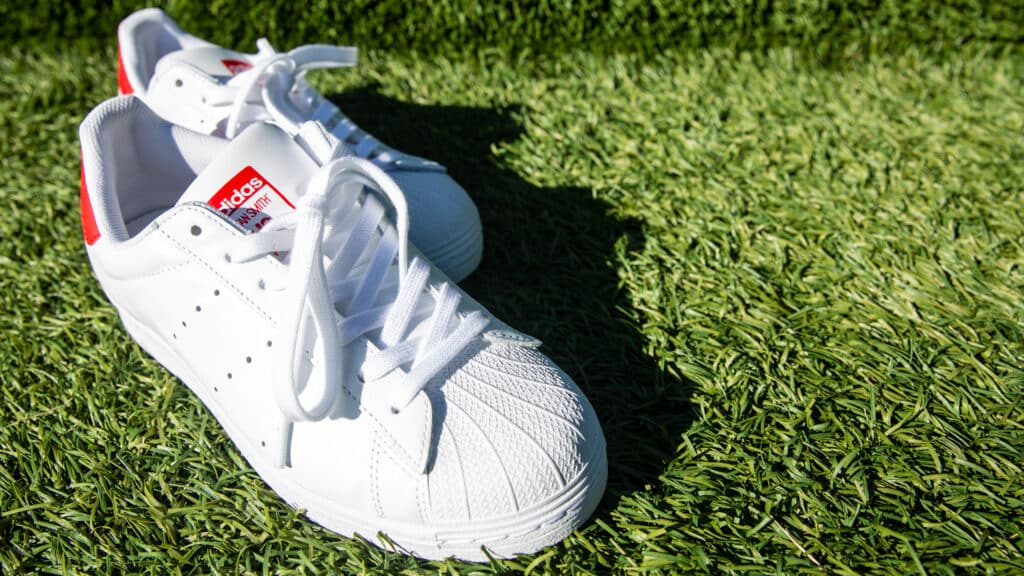By Sarah Stone
Sneakers are big business. Statista projects the global sneaker market will be worth $120 billion by 2030.
Delisia Matthews, associate professor in the Wilson College of Textiles, says underneath this booming industry lies an entire culture: sneakerheads. Through academic research, she’s become a leading expert on the topic. So what is a sneakerhead? Matthews, who has a doctorate in consumer, apparel and retail studies, says it’s more than just someone itching to buy the next pair of Jordans.
“There are multifaceted ways of defining a sneakerhead,” she says. “I think the traditional way that we have thought about the sneakerhead is regarding consumption, right? Someone who not only knows a lot about sneakers and the history behind different collections, but is also first in line to buy sneakers when a new collection drops.”
Growing up with a sneakerhead cousin provided the initial inspiration for her research.
“I was just always curious about how he chose the sneakers as they were related to the athletes that he followed, but also how he chose the sneakers based upon how he’d be able to style them. His style and even his confidence was deeply tied to the sneakers. And I’ve always been interested in consumer trends.”
Truly understanding the history, culture and contributions of sneakerheads to this now worldwide trend, she says, means respecting Black history.
“If we’re going to talk about sneaker culture, we definitely have to include the presence of African Americans or Black people. Black culture was foundational to the sneaker culture’s beginnings.”
In honor of Black History Month, Matthews shared more of her sneakerhead expertise in this Q&A.
You define sneakerhead as not just a collector but someone who is part of a larger sneakerhead culture. What are the defining characteristics of that culture?
So definitely the first thing I would say about sneakerheads with regards to the culture is they have their own lingo for sure. So there are phrases and words that those outside of the sneaker culture might not understand, like “hype beast,” “colorways,” “deadstock” and “drops.” The lingo helps cement the culture and sneakerheads automatically know if you’re aware of the sneaker culture if you use that lingo.
Another part of it is tapping into sneakerhead apps and being part of the sneakerhead community on social media. You’re looking for people who are authentic sneaker influencers, who know about the background of sneakers.
I will say the younger sneakerheads, they are interested in more of the celebrity collaborations, like the Travis Scott Jordans, Pharrell and his shoes, or even Kanye West’s line of shoes, despite the controversy. The older sneakerheads are still looking for those classic silhouettes and, those classic colorways. I do think that there’s this movement towards celebrities and their collaborations, but the athlete part is never gonna go away.
Another piece of it is the reverence with which you treat the sneakers. My cousin actually wore his but in my sneakerhead research I have also come across some sneakerheads who buy certain pairs and they never wear them. There’s also a third type of sneakerhead who will actually buy two pairs: one pair that they can wear and then a second pair that they never touch and plan on passing down to family members.
Your research has confirmed that Black people make up the largest consumer base for sneakerheads. What do you think the reason for that is?
If you look back at when sneakers became very popular from a style perspective. It wholeheartedly includes Black culture.
And I think that is because when you look at the roots of the sneaker culture, it definitely came from hip hop culture. One of the first songs that I think aligns with this is the song “My Adidas” by Run DMC, which came out in 1986. Thereafter, the Adidas Shell Toes became very popular because the style embodied the music and the culture. It had a whole vibe and set the stage for the sneaker culture. And so I very much think that that’s the reason why a large percentage of the consumption comes from the Black community with regards to the sneaker culture.

But everything is evolving. And so while that’s where the roots were and where things started, there are a lot more individuals who are becoming a part of the sneaker culture that might not be a part of that ethnic group, which is great. But for sure, it started with Black culture, and specifically hip hop culture.
Jordan 1s and the resulting Jordan Brand in many ways sparked the growth of sneakerhead culture. Is there a reason for this beyond basketball sneakers designed by one of the best basketball players of all time?
The Jordan 1s came out in 1985, but you know that when he actually wore those sneakers during the initial games, he continuously got fined. At the time, there was a certain colorway that was standard for all basketball shoes, and you were required to wear those standard colors. And he said, “No, I’m going to wear my shoes.”
And of course, he wore his shoes and then performed the way that he performed.So I think part of that is the reason why there’s so much appeal for the Jordan 1s because people know that he went against the grain to stand behind his product and then he backed it up by his performance on the court. It’s that counterculture mindset that makes the Jordans appealing in addition to him being Michael Jordan.
And then I do also think that it’s the way that the shoe was put into pop culture. So this is really related to Black history as well. Jordan 1s were featured in a lot of different Black TV shows and movies in the 1980s, which made them even more popular, like “Do the Right Thing” by Spike Lee and “Fresh Prince of Bel Air” to name a few.
What’s a “hypebeast”? Would you consider it a form of misappropriation?
The definition of hypebeast depends on which type of sneakerhead you talk to, but overall it’s someone who jumps on anything within the sneaker culture that’s “hype,” or popular. They don’t care about the background or the history. They don’t care about why it’s hype.

Most of the sneakerheads really dislike hypebeasts because they also might be a part of the buy/sell/trade community, so they buy it, at its height and then they mark it up. And so the true sneakerheads are frustrated that they might not be able to afford their favorite sneaker because this hypebeast has purchased it and marked up the price.
I don’t necessarily think I would call it misappropriation per se, but definitely they don’t have a respect and deep understanding of the culture from a historical perspective.
We’ve seen such a big spread of sneakers into popular fashion/the greater public, from the widespread pairing of sneakers with suits to the launch of sneaker lines by bohemian brands like Free People and couture designers. Is this in line with the general cycle of how trends get adopted?
Yes, and there’s a specific theory academics use to explain it called trickle up or upward flow theory.We have different types of fashion that typically comes from, I’ll call it “the streets,” or streetwear, right? But over time, it becomes popular and more widely accepted. And then once it becomes widely accepted, it actually trickles up to more affluent individuals
So that’s the reason why we had sneaker styles that were prevalent among maybe Nike to begin with, but now Gucci, Christian Dior and other luxury brands have sneakers, and other luxury brands.
How do the older generation of sneakerheads feel about that?
I think that’s a touchy subject. Because it’s kind of similar to the sentiments around the widespread popularity of hip hop. You’re excited that more people are accepting it, but at the same time, you hope that they understand the foundation and the history of it.
Sneakerheads want it to be more widely accepted, but they also want to make sure that when you rock the Jordans you understand the history behind it, just out of respect.
- Categories:



